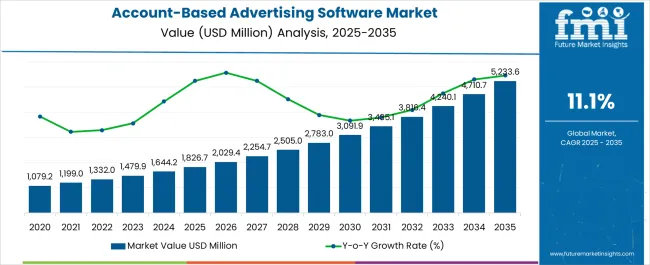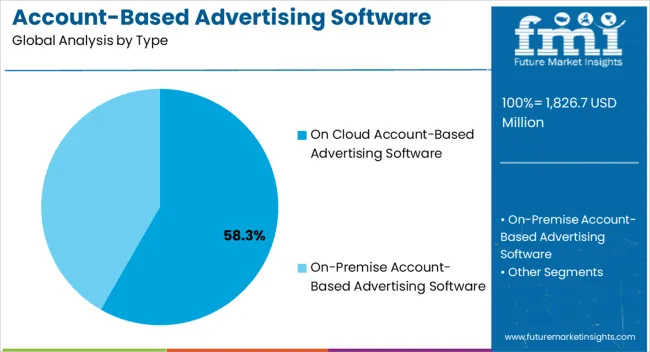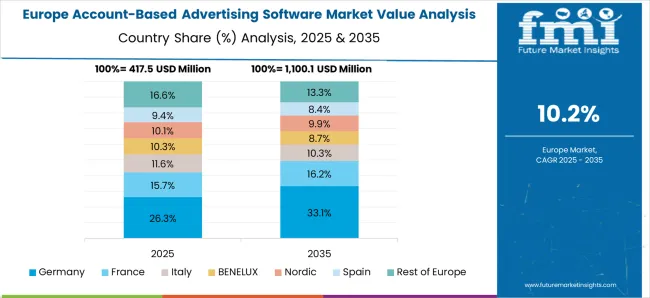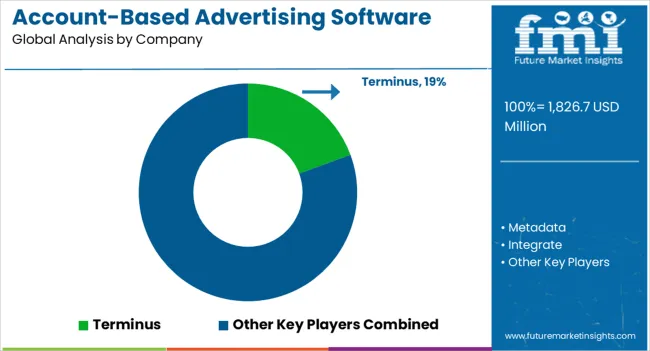The Account-Based Advertising Software Market is estimated to be valued at USD 1826.7 million in 2025 and is projected to reach USD 5233.6 million by 2035, registering a compound annual growth rate (CAGR) of 11.1% over the forecast period.

| Metric | Value |
|---|---|
| Account-Based Advertising Software Market Estimated Value in (2025 E) | USD 1826.7 million |
| Account-Based Advertising Software Market Forecast Value in (2035 F) | USD 5233.6 million |
| Forecast CAGR (2025 to 2035) | 11.1% |
The account based advertising software market is expanding rapidly due to the increasing focus of enterprises on personalized marketing, measurable ROI, and alignment between sales and marketing teams. The shift toward data driven strategies has been reinforced by the rising adoption of digital platforms and the growing need to engage high value accounts with tailored campaigns.
Cloud based deployment models, AI powered analytics, and integration with CRM platforms are enhancing the scalability and efficiency of account based advertising tools. Enterprises are prioritizing solutions that provide real time insights, seamless collaboration, and advanced targeting capabilities.
The outlook remains positive as businesses continue to prioritize customer centric approaches, strengthen engagement with key clients, and optimize marketing expenditure for greater efficiency and performance outcomes.

The on cloud account based advertising software type segment is projected to account for 58.30% of total revenue by 2025 within the type category, positioning it as the leading deployment model. This growth is attributed to the flexibility, cost effectiveness, and ease of integration offered by cloud based solutions.
Businesses are increasingly adopting cloud platforms to support scalability, reduce infrastructure costs, and enable real time access across distributed teams. Enhanced security measures and compliance features have further encouraged adoption across industries handling sensitive client data.
Additionally, the continuous updates and seamless integration with third party tools provided by cloud vendors have strengthened the appeal of this model. As enterprises seek agility and faster deployment cycles, on cloud platforms have emerged as the preferred choice, securing their leadership position in the type segment.
Account-based marketing, of which account-based advertising is an important part, is witnessing a boost in demand as companies attempt to leverage the benefits it provides to sales cycles, customer retention, ROI and lead generation.
According to research, around 87% of B2B marketing teams say that their ABM efforts showed better ROI than their other efforts. Around 91% of companies using ABM reported increased average deal size, and a 70% reported increase in opportunities owing to ABM. Through the use of targeted ABM Platform, enterprises can show consumers that they understand their needs.
Through account-based advertising, companies can directly provide ads to businesses they want to target, ensuring that resources are focused only on accounts that are highly likely to convert and provide deals of larger sizes.
Companies are benefiting from the advantages of using ADM platforms that can allow for access to the ability to leverage IP addresses and cookies and use advanced artificial intelligence and machine learning technologies for their B2B marketing.
This software can also be integrated with CRM and marketing tools and run multichannel campaigns across personas stages and campaigns. The automation of the ABM process is beneficial since it can shorten the sales cycle and provide a greater ease of scalability.
Personalised landing pages, attractive emails, chatbots and other personalised techniques can help in order to scale. However, the high costs of set up and resources required due to the targeted nature of this advertising serves as a restraint.
With the help of ABM, one can make the most out of their clients and build long-term relations with their end-users. The initial stages require significant investments; however, they reward the user in the long run.
In contrast to conventional tactics, these investments are exceedingly low, plus they require little to no cost for sustainability. This is especially the case for social media posts, which have long-term opportunities to boost brand awareness.
In general, businesses using ABM can control which potential customers they do business with, which cuts down on transaction times considerably. Nevertheless, ABM demands steep investments to make business possible.
It is more customized as opposed to general occupational therapy, which is not quite focused on the specific requirements of each client.
The approach is more personal than the more general types of occupational therapy, which requires more specific research for each individual.
According to research, the misalignment between sales and marketing teams can cost businesses over USD 1 trillion in just a year. In a survey conducted amongst sales and marketing teams, 90% reported a misalignment.
Almost all those asked in survey believed this was harmful to their organization and target accounts as well. According to another study, enterprises where these teams are not misaligned have 36% higher retention rate, 67% higher chances of customer conversion and 38% higher sales win rates.
Under traditional lead-based marketing, sales and marketing teams work separately and have a higher chance of misalignment. This can lead to unqualified leads with conversion rates and chances of displaying lower retention.
Under ABM, both sales and marketing teams must come together to select accounts. In turn, only these accounts are targeted by the advertising teams. Further, only leads that have high potential to be productive and qualified, reach sales teams.
Once these teams are selected, it is the marketing teams that must take on the burden of attracting the potential consumers from the selected pool of target accounts through highly personalised and effective advertising strategies and techniques. This level of high collaboration also means that tracking ROI becomes easier.
According to a study conducted amongst ABM markets, 42% believed that lead generation was one of the key indicators of performance. Instead of catching a wide range of potential customers quickly, ABM strategies target a narrower range of customers and targets them with effective advertising strategies.
Further, instead of focusing only on new leads, ABM also looks at retaining existing consumers through upselling and cross selling. For Example, LiveRamp used their ABM to connect and get meetings with 15 different target clients.
A media company, GumGum, wanted to attract executives at McDonald’s. They sent out advertising in the form of burger “kits” for a select few top executives that contained information advertising their services, as well as a personalised receipts with the executive’s names, which helped them secure a meeting with some key decision makers.
Account based advertising can significantly improve customer relations. Highly personalized ads can help organizations get much closer to their customers.
Unlike traditional marketing, which uses generalized messages, ABA advertising entails personalized messaging for individual customers, so that enterprises can understand their accounts and get closer to the messages recipients.
Further when advertising is in the form of ABA, the advertising is on the specific form of communication and media suitable for a particular customer. This leads to higher customer engagement, and eventually, higher customer retention.
| Segment | Large Companies |
|---|---|
| Value Share % (2025) | 56.5% |
Large companies are the top application for account-based advertising, having witnessed a CAGR of 11.1% with a forecast CAGR of 10.2%. While it does have several benefits, account-based advertising requires higher amounts of resources.
According to a study, 37% of marketing teams have trouble in getting resources. Enterprises with products that have high values per customer and a relatively smaller market to target, benefit the most from this software.
This tends to be larger enterprises that can afford the extensive data and resource requirements. For smaller businesses or businesses that require less sophistication in their sales cycles, other forms may prove more helpful. However, small and medium companies are also turning to 1: Many forms of ABM campaigns in recent years.

| Region | Europe |
|---|---|
| Market Share % (2025) | 26.5% |
Europe in an emerging market for demand with a 26.5% market share in 2025 and a predicted market size of USD 5233.6 million by 2035. According to a study conducted amongst 500 marketing professionals, it was observed that nearly 86% of European companies reported plans to use account-based marketing and account-based advertising in the near future.
The United Kingdom also emerged as a key country for demand, with the study indicating that 55% respondents showed interest in implementing these strategies.
| Country | The United States |
|---|---|
| Market Share % (2025) | 17.7% |
The United States accounted for over 17.7% of the global account-based advertising software market in 2025. The United States is projected to account for an absolute dollar opportunity of USD 1826.7 million between 2025 and 2035 and a forecast market size of USD 5233.6 million by 2035 at 10.6% CAGR.
A study conducted across marketing professionals showed that 47% of marketers are already using an ABM technique.
Cloud based advertising software is the significant type of account-based advertising software, with a historical CAGR of 11.4% and a forecast CAGR of 10.7% in 2025 to 2035.
Cloud based systems are highly beneficial since they enable enterprises to access to a wide range of tools and reduces the burden on IT team. For one, cloud systems ensure easy access to customer data that is expected to be harder to store if traditional methods of storage are employed.
Furthermore, cloud is accessible anywhere anytime, enabling ease of remote work and improving collaborative possibilities.
Besides, cloud-based systems allow for access to a far wider range of powerful analytic tools that can help gain insights on the customer base. This can also help identify and track which methods work the best and which ones are not to ensure the optimal use of time and resources.

At present, account-based advertising software providers are focused on developments that are expected to afford more opportunities for targeting and analysis to marketing professionals.
The key companies operating include Terminus, Metadata, Integrate, 6sense, RollWorks, Madison Logic, Triblio, ListenLoop, Jabmo, Demandbase, Mintigo, Radiate B2B, Recotap, Bluebird, Kwanzoo Inc, MRP and IDG Communications.
Some of the recent development in account-based advertising software are as follows:
Similarly, recent developments related to ABM software companies have been tracked by the team at Future Market Insights, which is available in the full report.
The global account-based advertising software market is estimated to be valued at USD 1,826.7 million in 2025.
The market size for the account-based advertising software market is projected to reach USD 5,233.6 million by 2035.
The account-based advertising software market is expected to grow at a 11.1% CAGR between 2025 and 2035.
The key product types in account-based advertising software market are on cloud account-based advertising software and on-premise account-based advertising software.
In terms of application, large companies segment to command 62.7% share in the account-based advertising software market in 2025.






Full Research Suite comprises of:
Market outlook & trends analysis
Interviews & case studies
Strategic recommendations
Vendor profiles & capabilities analysis
5-year forecasts
8 regions and 60+ country-level data splits
Market segment data splits
12 months of continuous data updates
DELIVERED AS:
PDF EXCEL ONLINE
Account-Based Data Software Market Size and Share Forecast Outlook 2025 to 2035
Account-Based Direct Mail Software Market Size and Share Forecast Outlook 2025 to 2035
Advertising Optimization Plan Market Size and Share Forecast Outlook 2025 to 2035
Travel Advertising Market Size and Share Forecast Outlook 2025 to 2035
Social Advertising Tools Market Size and Share Forecast Outlook 2025 to 2035
Native Advertising Market Analysis - Trends & Forecast 2025 to 2035
Native Video Advertising Market Size and Share Forecast Outlook 2025 to 2035
Social Video Advertising Market Size and Share Forecast Outlook 2025 to 2035
In-flight Retail and Advertising Market Size and Share Forecast Outlook 2025 to 2035
Cross-Platform & Mobile Advertising Market Report – Growth 2018-2028
Software Defined Vehicle Market Size and Share Forecast Outlook 2025 to 2035
Software Defined Networking (SDN) And Network Function Virtualization (NFV) Market Size and Share Forecast Outlook 2025 to 2035
Software Defined Perimeter (SDP) Market Size and Share Forecast Outlook 2025 to 2035
Software-Defined Wide Area Network SD-WAN Market Size and Share Forecast Outlook 2025 to 2035
Software Defined Radio (SDR) Market Size and Share Forecast Outlook 2025 to 2035
Software License Management (SLM) Market Size and Share Forecast Outlook 2025 to 2035
Software-Defined Networking SDN Market Size and Share Forecast Outlook 2025 to 2035
Software-Defined Anything (SDx) Market Size and Share Forecast Outlook 2025 to 2035
Software-Defined Data Center Market Size and Share Forecast Outlook 2025 to 2035
Software Containers Market Size and Share Forecast Outlook 2025 to 2035

Thank you!
You will receive an email from our Business Development Manager. Please be sure to check your SPAM/JUNK folder too.
Chat With
MaRIA